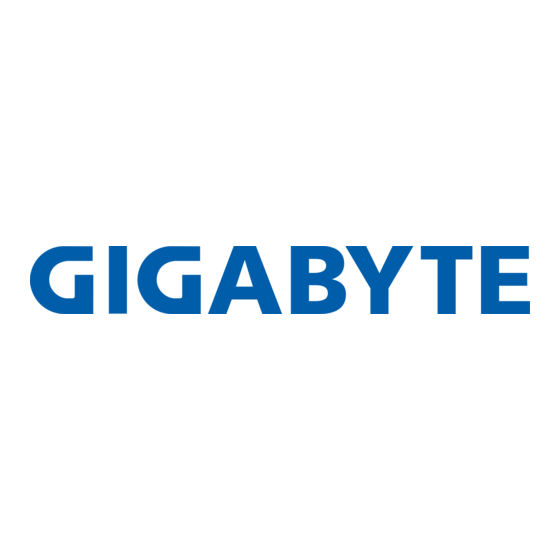
Table of Contents
Advertisement
Quick Links
GA-686BLX
TABLE OF CONTENTS
1.
INTRODUCTION .........................................................................................................1-1
1.1. PREFACE.............................................................................................................1-1
1.2. KEY FEATURES ..................................................................................................1-1
1.3. PERFORMANCE LIST.........................................................................................1-2
1.4. BLOCK DIAGRAM ...............................................................................................1-3
1.5. INTRODUCE THE Pentium ® II Processor & AGP ..............................................1-4
What is AGP? ..............................................................................................................1-6
2.
SPECIFICATION.........................................................................................................2-1
2.1. HARDWARE ........................................................................................................2-1
2.2. SOFTWARE.........................................................................................................2-2
2.3. ENVIRONMENT...................................................................................................2-2
3.
HARDWARE INSTALLATION....................................................................................3-1
3.1. UNPACKING ........................................................................................................3-1
3.2. MAINBOARD LAYOUT ........................................................................................3-2
3.3. QUICK REFERENCE FOR JUMPERS & CONNECTORS ................................3-2
3.4. DRAM INSTALLATION........................................................................................3-4
3.5. CPU SPEED SETUP ...........................................................................................3-5
3.6. CMOS RTC & ISA CFG CMOS SRAM................................................................3-5
3.7. SPEAKER CONNECTOR INSTALLATION ........................................................3-6
3.8. HARDWARE RESET SWITCH CONNECTOR INSTALLATION.......................3-6
3.9. POWER LED CONNECTOR INSTALLATION ...................................................3-6
3.10. IDE & ATAPI DEVICE INSTALLATION.............................................................3-6
3.11. PERIPHERAL DEVICE INSTALLATION...........................................................3-6
3.12. KEYBOARD & PS/2 MOUSE INSTALLATION..................................................3-6
4.
BIOS CONFIGURATION.............................................................................................4-1
19
Advertisement
Table of Contents

Summary of Contents for Gigabyte GA-686BLX
-
Page 1: Table Of Contents
GA-686BLX TABLE OF CONTENTS INTRODUCTION ......................1-1 1.1. PREFACE......................1-1 1.2. KEY FEATURES ....................1-1 1.3. PERFORMANCE LIST..................1-2 1.4. BLOCK DIAGRAM ....................1-3 1.5. INTRODUCE THE Pentium ® II Processor & AGP ..........1-4 What is AGP? ......................1-6 SPECIFICATION......................2-1 2.1. HARDWARE ......................2-1 2.2. SOFTWARE......................2-2 2.3. ENVIRONMENT....................2-2 HARDWARE INSTALLATION..................3-1... - Page 2 Table of Contents 4.1. ENTERING SETUP .....................4-1 4.2. CONTROL KEYS ....................4-1 4.3. GETTING HELP....................4-2 4.3.1. Main Menu....................4-2 4.3.2. Status Page Setup Menu / Option Page Setup Menu.......4-2 4.4. THE MAIN MENU....................4-2 4.5. STANDARD CMOS SETUP MENU ..............4-4 4.6. BIOS FEATURES SETUP ...................4-8 4.7.
-
Page 3: Introduction
GA-686BLX INTRODUCTION 1.1. PREFACE Welcome to use the GA – 686BLX motherboard. The motherboard is a Pentium ® II Processor based PC / AT compatible system with AGP / PCI / ISA Bus, and has been designed to be the fastest PC / AT system. There are some new features allow you to operate the system with just the performance you want. -
Page 4: Performance List
Introduction 27cm x 22cm BABY SIZE form factor, 4 layers PCB. 1.3. PERFORMANCE LIST The following performance data list is the testing results of some popular benchmark testing programs. These data are just referred by users, and there is no responsibility for different testing data values gotten by users. -
Page 5: Block Diagram
GA-686BLX Hi-End 30.6 32.6 1.4. BLOCK DIAGRAM 66MHz 14.318MHz 3.3V EDO/SDRAM SLOT DIMM Sockets Host Bus 82432LX 66MHZ AGP Bus CHIPSET DRAM Bus 66MHz 33MHz 52C64-25 33MHz Ultra DMA/33 IDE Ports 52C64-06 PCI Bus 33MHz IDE Bus 14.318MHz 33MHz PIIX4... -
Page 6: Introduce The Pentium ® Ii Processor & Agp
Introduction 1.5. INTRODUCE THE Pentium ® II Processor & AGP Figure 1:Retention Mechanism & attach Mount Figure 2:OEM Pentium ® II Processor... - Page 7 GA-686BLX Figure 3:Heatsink / FAN & Heat sink support for OEM Pentium ® II Processor Figure 4:Boxed Pentium ® II Processor & Heat sink support...
-
Page 8: What Is Agp
Introduction What is AGP? The Accelerated Graphics Port (AGP) is a new port on the Host-To-PCI bridge device that supports an AGP port. The main purpose of the AGP port is to provide fast access to system memory. The AGP port can be used either as fast PCI port (32-bits at 66MHz vs. 32- bits at 33MHz) or as an AGP port which supports 2x data-rate, a read queue, and side band addressing. -
Page 9: Specification
GA-686BLX SPECIFICATION 2.1. HARDWARE • Pentium ® II processor 200 – 633 MHz. − − 242 pins 66MHz slot1 on board. • − Onboard Speaker Alarm when detect "CPU FAN PROTECTION Failure" or “ CPU Overheat” . − Automatically slow down CPU speed when "CPU Overheat". -
Page 10: Software
Specification • − Supports 2 16550 COM ports. (Using IRQ4, 3) I/O PORTS − Supports 1 EPP/ECP LPT port. (Using IRQ7 or 5 and DMA3 or 1) − Supports 1 1.44/2.88 MB Floppy port. (Using DMA2 & IRQ6) − Supports 2 USB ports. −... -
Page 11: Hardware Installation
GA-686BLX HARDWARE INSTALLATION 3.1. UNPACKING The mainboard package should contain the following: • The GA – 686BLX mainboard. • The Retention Mechanism & Attach Mount • USER'S MANUAL for mainboard. • Cable set for IDE, Floppy & I/O devices. •... -
Page 12: Mainboard Layout
Hardware Installation 3.2. MAINBOARD LAYOUT SOFT PWR SLOT4 SLOT3 + + + BIOS SLOT2 SLOT1 PCI4 PIIX4 PCI3 PCI2 GA-686BLX PCI1 IDE2 IDE1 BAT1 AGP1 COMB FAN PWR 82443LX COMA PS/2 MOUSE SLOT1 FLOPPY BANK1 BANK3 BANK2 BANK0 ×Figure 3.1Ø... - Page 13 GA-686BLX GN : GN-SW Pin No. Function CTRL-Signal HD : Hard Disk active LED (HD-LED) Pin No. Function LED POWER (+) LED POWER (-) LED POWER (-) LED POWER (+) J1 : slot 1 For Pentium ® II processor installed J2 : CPU cooling FAN Power Connector Pin No.
-
Page 14: Dram Installation
Hardware Installation Signal J17 : ACPI LED selection Pin No. Function Signal JP6 : Keyboard Power On Connector Pin No. Function Close Enabled Keyboard power on. Open Disabled Keyboard power on. RST : RESET Switch Pin No. Function RESET Input PWR : POWER ON LED ( PW-LED), Key Lock Pin No. -
Page 15: Cpu Speed Setup
GA-686BLX EDO & 67~100 MHz for SDRAM. The DRAM memory system on mainboard consists of bank 0, 1, 2 & bank 3. Because the 168 pins DIMM module is 64 bits width, using 1 PCS which can match a 64 bits system. The total memory size is 8 MB ~ 1 GB EDO / 512MB SDRAM. -
Page 16: Speaker Connector Installation
Hardware Installation the system can automatically boot OS. every time. Due to the life-time of Battery internal battery is 5 years, the user can change a new Battery to replace old one after it can not work. 3.7. SPEAKER CONNECTOR INSTALLATION There is a speaker in AT system for sound purpose. - Page 17 GA-686BLX port if it is installed. After installing the peripheral device, the user should check everything again, and prepare to power-on the system.


Need help?
Do you have a question about the GA-686BLX and is the answer not in the manual?
Questions and answers